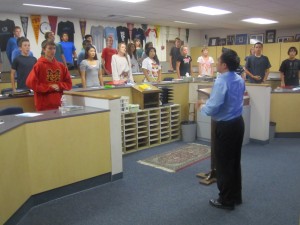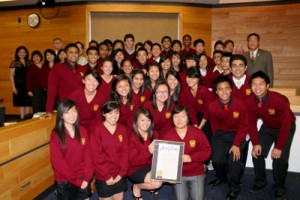
Cerritos has a large class program and has enough delegates to attend conferences on consecutive weekends. They won delegation awards at both Nationals NHSMUN and Berkeley BMUN in 2011 and will be sending teams to both conferences on the same weekend in 2012.
Model UN is decentralized and has grown autonomously around the world. This has led to big differences in how Model UN is done. We already explored the key differences between the “World Division” and the “National Division” at the college level and the key differences between THIMUN-affiliated MUN and North American MUN at the high school level. But even within the North American high school level, there seems to be significant differences between how Model UN is done on the West Coast compared to the East Coast.
West Coast teams have historically traveled East starting with Huntington Beach’s victory at Harvard in 1973, and teams like Edison and Mira Costa have been successful at East Coast conferences like Harvard and Georgetown since 1980s and 1990s. Since the 2000s, many more teams from the West Coast have traveled to East Coast conferences every year, but it doesn’t happen often the other way around and it seems like teams from the East Coast and beyond are still relatively unfamiliar with West Coast MUN. West Coast schools shined at Georgetown NAIMUN in 2010 with Mira Costa winning Best Large and Cerritos winning Best Small, and the conversation has been building up (due, in part, to the creation of this website and its rankings) to Mira Costa’s return to NAIMUN this year, which illustrated to teams on both coasts what some of those differences are.
What are the key differences between Model UN in the West Coast and how it’s done elsewhere, particularly the East Coast? More importantly, is there something that other regions can learn from West Coast Model UN?
This article is written from a West Coast perspective as contrasted to East Coast MUN. We purposefully contrasted it this way since both coasts mostly see Model UN as more of an academic competition and put an emphasis on awards whereas other regions such as the Midwest see Model UN as more of an educational simulation and don’t focus as much on awards. The takeaways are meant to highlight what West Coast teams think are positives to the way they do Model UN.
It’s important to note that when we say “West Coast,” we’re really referring to Southern California and specifically the big seven class programs that influence the activity with teams that contain 200-300 students each: Mira Costa, Huntington Beach, Cerritos, Edison, Mission Viejo, Santa Margarita, and Tustin. Most of the other Southern California programs are actually clubs, not classes, but still fit culturally into the “West Coast” circuit and do MUN the same way as described below. Schools in Northern California and other West Coast states tend to have MUN as a club and not all conferences resemble what’s simulated in Southern California. And when we say “East Coast,” it captures the MUN culture and operations for the Northeast corridor, specifically the college-hosted conferences and the high schools that attend them, as well as a few conferences and high schools in other regions that are influenced by the East Coast.
With that said, here are the five key differences between West Coast Model UN contrasted to how it is done on the East Coast and the effect each of these aspects have on the activity.
1. Model UN can be taken as a class on the West Coast, and this leads to an emphasis on research and preparation.
Model UN can be taken as a class in the big seven programs. It varies at each school; some schools have it where all freshmen who want to take honors world history & geography are automatically enrolled into Model UN and students go through a four-year curriculum where Model UN is integrated into their social studies classes, while other schools have it as an international relations elective or independent study period. Seniors at most of the schools help teach the class or serve as student advisors.
Regardless of the format, there is a much stronger focus on the academic side of Model UN in all the classrooms. Teachers are helping their students learn to be better researchers, writers, and thinkers. Students are required to complete assignments such as position papers, country profiles, and background guides and are graded on the quality of their work. Oftentimes this work is submitted to websites like turnitin.com to ensure that it is not plagiarized. Students are also required to attend a minimum number of conferences and staff their home conference in order to pass the class, and at a few programs the students’ performances at these conferences help determine their grades in the class.
The result of taking MUN as a class — and the fact that almost all West Coast conferences give out Research Awards for best position papers and count the points earned on position papers to determine delegate awards — is that students spend a lot more time researching for their papers and preparing for the conferences. There’s a culture of research and preparation. Their position papers are filled with facts and cited sources that back up their policies and potential solutions, they prepare research binders, and in Mira Costa’s case, they prepare laminates which are visually-friendly versions of the one-page policy memos or talking points that diplomatic officials use in real meetings. Students have to defend their ideas and address criticisms during “roasts” (Socratic questioning) by their teachers and peers, so they can’t make things up that are logically flawed or not backed by research. All this translates to an in-depth understanding of policies and feasibility of solutions. In committee, this may mean that they’ll be more assertive in pushing their solutions because they know they are realistic, and they may be less willing to compromise on “creative” solutions that they know are flawed.
In contrast, East Coast programs are usually clubs. The amount of time that a club spends on research and preparation varies significantly, as does the amount of time that a teacher can spend with the students. Research is still important to East Coast teams and is still necessary to succeed at East Coast conferences, but students do not necessarily undergo the same level of outside scrutiny on their research and preparation. Part of it is because their papers aren’t graded. But the real driving factors are seen in what the East Coast conferences value. A good number of conferences do not require position papers, and if they do, they do not grade them, give awards for them, or include them into consideration for delegate awards. There is also a higher proportion of crisis committees, especially those where the crisis staff decides to re-write history, so research is de-emphasized in favor of creativity.
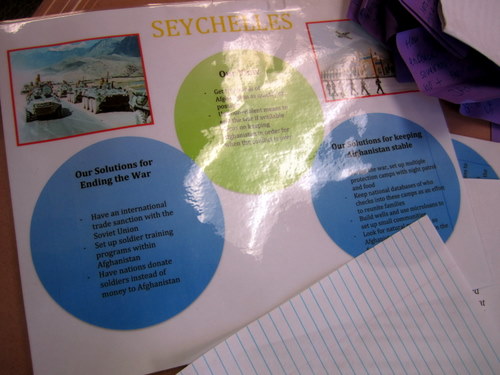
Delegates were concerned about Mira Costa's laminates during NAIMUN, but on a closer look of this example from MUNUC 2011, the content is not any different than a page of bullet points that delegates can write on a piece of paper. In fact, more schools should teach their delegates to clearly and concisely frame their ideas. Mira Costa delegates also often hand their laminates over to others in committee who want to learn about their core ideas.
(Personal memories: I went to a club program but we took our research just as seriously. I remember writing 15-page position papers per topic in preparation for Berkeley BMUN. Teachers always said that the background guide should only be a starting point, and we would take that literally and try to out-write the length of the background guides. Most conferences now have one or two page length requirements to help delegates write more concisely.)
2. West Coast conferences tend to judge delegates using points, and that leads to an emphasis on participation in addition to results.
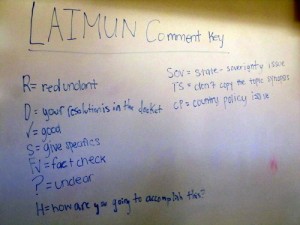
Mira Costa hosts the one-day LAIMUN novice conference. Chairs can provide comments on delegate performance so that they learn early on to research beyond the topic synopsis, back up their arguments with facts, and be more specific on their solutions
Perhaps due to the influence of MUN classes and grades, West Coast conferences tend to judge delegates using a points system whereas most East Coast conferences judge holistically. In the points system, delegates can earn points for every action that they take, and there is usually a standardized rubric that provides metrics on how the chairs should be assigning points. For example, a speech may be worth up to ten points (five for substance and five for style) while a comment during moderated caucus can be worth up to five points. The points are then tallied together to determine the award winners. Occasionally the chairs will ask for the committee to vote on who they thought was the Best Delegate (called “Rapporteur”) as an informal calibration on their scoring.
The scoresheets are usually sent to the schools after the conference is over so that teachers and students can reflect on their performance and understand what a conference was looking for. Some of the scoresheets will also contain comments from the chairs. Due to this transparency, the scoring system has become relatively standardized among conferences that use it.
The result of the points system is that it leads to an emphasis on participation and process in addition to results, and it drives different behaviors among the chairs and delegates. The chairs have to listen more closely to each speech in order to grade it, and the entire dais needs to go out during unmoderated caucus to score every delegate on their participation. As for the delegates, they are more willing to stay on the Speaker’s List (relative to delegates on the East Coast) because the speeches are worth more points, and both delegates will go up to make the speech together so both can get credited for it. Some delegates will try to dominate the unmoderated caucus blocs whenever they see the chairs walking by with their notepads. Making one additional action such as one more speech than everyone else will yield a big advantage in points, although some of the larger conferences usually fix this with counterweights such as averaging the points, only scoring the same number of speeches for each delegate, or by adding holistically-judged “diplomacy points” to a delegate that deserved to win but was at a disadvantage for not being called on.
All this is a huge contrast to East Coast conferences that use holistic judging. In holistic judging, delegates have to do their best without knowing what they chairs are looking for specifically and hope that they stand out when presenting resolutions and in whatever other areas the chair values in order to receive an award. The criticisms against holistic judging is that it lacks transparency, standardization, rubrics/metrics, and sometimes accountability of the chairs to pay attention throughout the entire debate. In addition, very few East Coast conferences post up their awards policies, but even then it may be difficult to decipher whether that conference values competition versus education, leadership skills versus substantive content, and creativity versus accuracy (these are three philosophical spectrums behind organizing a conference). West Coast delegates attending East Coast conferences should realize that they are more results-oriented (e.g. you want to be a primarily sponsor of the resolution) and that it’s more about presence than points (e.g. it’s okay to go into moderated caucus at the expense of the Speaker’s List).
Ultimately, the points system was created as a process to teach students to participate in committee and to provide feedback for students who are studying Model UN in a classroom environment. Teachers wanted to hold their students accountable to making speeches and participating in caucus as discussed or practiced in class. The feedback and accountability plus its transparency and standardization makes it a favorable evaluation tool for most educators. Students used to this system may eventually outgrow process (points) in favor of results (holistic judging) and can do fine at East Coast conferences, but they may still become frustrated at holistic judging due to the lack of standards and specific feedback.
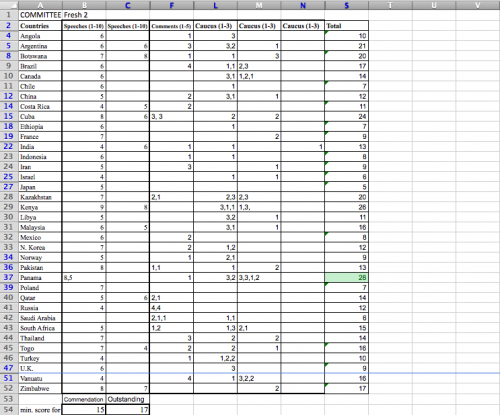
Here's a closer look at a simplified scoresheet from Santa Margarita's SOCOMUN novice conference. Points are earned for each action (up to 10 for speeches, 5 for comments, and 3 for caucus in this example) and then tallied to determine the award winners. Notice that there are point thresholds for winning Outstanding and Commendation (Honorable Mention)
(Personal memories: One time, there were five top sponsors on a caucus bloc but only four were allowed to present the draft resolution. I remember I lobbied for Australia to be one of the four but the other three power delegates left her out. She was heartbroken, but then she ended up winning the gavel anyway. In retrospect, the chairs had been grading throughout committee and recognized her contributions without having to rely on the presenting sponsors to determine the awards).
3. The high schools host many of the larger conferences on the West Coast, and that gives them the ability to influence the policies and growth of the circuit.
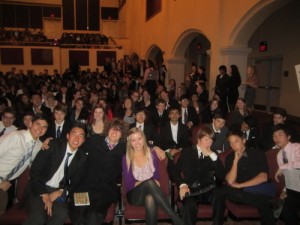
Huntington Beach hosts two conferences a year: the Surf City advanced conference in February and the Huntington Beach novice conference in April. These conferences are larger than most of the college-hosted ones on the West Coast.
California has the most Model UN conferences of any state, and that’s partially attributed to the fact that so many high school programs host their own conferences. Although a few schools do host conferences on the East Coast and in different regions across the United States, it is not common and college-hosted conferences dominate the circuit in size and quantity. High school students running their own conferences is more common worldwide, especially with all the THIMUN-affiliated conferences around the world, so the East Coast is actually an anomaly.
West Coast programs host conferences for two reasons. First, it is an educational experience to manage your own conference and chair a committee, and teachers really value this experience. Second, hosting a conference serves as a fundraiser for the team as the delegate fees that they collect get re-invested into their own travel expenses. Since some of these programs are large classes, they also have big enough staffs to host conferences up to 1,000 delegates. Luckily, Southern California also has a large population which makes it mutually beneficial; the conference can draw many local delegates and the attending schools do not have to spend much money or time to go to a conference.
Essentially, everyone ends up going to each others’ conferences — the high school-hosted conferences form the core of the circuit’s schedule — and that has led to a circuit where the ability to influence the activity resides with the high school programs instead of the college conferences. Teachers see each other often and are well connected; they share resources, bring up circuit-wide issues, influence conference policies to match their educational philosophies, and provide feedback on which conferences to attend. The latter causes conferences to take feedback for improvement more seriously, otherwise a large delegation can take their large teams (and delegate fees) elsewhere and perhaps influence other teams to do the same. In addition, new teachers and clubs can get instantly plugged into this network of resources and grow much faster within the support system, and experienced teachers have an incentive to train and recruit these newer schools to attend their conferences.
In contrast, the East Coast conference calendar is dominated by the college-hosted conferences and reasonably so since there are many top colleges on the East Coast. Only a few high school programs host their own conferences which means delegates learn mostly through trial by fire at large conferences, and students rarely experience the staffing side until they get to college. The lack of a local circuit means that teams do not consistently see each other and may make it more difficult to network and help each other out. High school programs have less of an ability to influence the circuit-wide development of Model UN. And delegates have to spend more money and time to travel to conferences without funding that could’ve come from hosting their own conference.
(Personal memories: Ryan and I both served as Secretary-General of our respective programs in high school. We both had to run our own conferences, and we learned a lot of valuable lessons on leadership and management at a young age. As I mentioned in my reflections post, I valued the Kofi Annan Award for Best Secretary-General over my gavels, and I think more high school students should go through this experience).
4. The West Coast has a novice circuit, and that allows the mass sustainable development of new delegates.
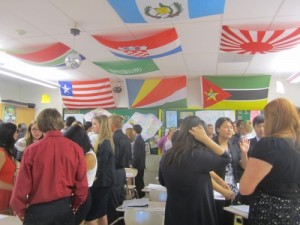
Edison's EHSMUN is one of several conferences that host a combination of one-day novice committees and two-day advanced committees. They also do a great job decorating their committee rooms.
Some of the high school-hosted conferences on the West Coast are novice conferences. Novice conferences are typically one-day (which means students don’t have to miss class), have committees that are 30 students or less (to allow for more participation), and may have docket-style debate where delegates focus on amending pre-submitted resolutions instead of writing them from scratch in committee (this saves time and puts the learning focus on solutions instead of just policy). Some conferences combine a schedule that includes one-day novice committees and two-day advanced committees. And a few specialize in only Security Council committees or crisis committees to give novices a taste of these experiences without getting overwhelmed by the most advanced delegates.
Put together, there is about one novice conference every month to choose from and newer delegates will go through a novice-specific circuit before advancing into intermediate, advanced, and travel conferences in subsequent years. This is also a reflection of how the students are taking different social studies classes together at each grade level. The layering of different experience levels on the West Coast circuit is similar to how sports are divided into freshmen, JV, and varsity levels. In fact, some class and club programs give out varsity letters to their experienced delegates who met a certain level of criteria. It is also notable that some of the high school programs will host a weeklong summer program for their incoming freshmen or do outreach to their middle schools to get them started early so that they can jump straight into their first novice conference having already learned the basics.
The availability of the novice circuit allows the mass, sustainable development of new delegates. Schools can take their huge freshman classes of over 100 delegates and place them in an educational environment that won’t overwhelm them. This helps aid the development of skills and confidence in the delegates, particularly those who were naturally more shy. The novice conferences also give out a much higher percentage of awards — sometimes up to 50% of the committee since so many of them are deserving of recognition. The individual awards reinforce the novices’ newfound confidence and encourage them to continue participating in Model UN. Almost all of them don’t give out gavels or school delegation awards since the conferences aren’t meant to be competitive.
The East Coast is comprised of mostly large, competitive conferences. Ryan and I inevitably meet a newer advisor who feels overwhelmed at every large conference that we attend, and unfortunately they don’t have many other choices that are more appropriate for their delegates’ experience level. High school-hosted conferences like Horace Mann HoMMUNC, Thomas Jefferson TECHMUN, Stuyvesant StuyMUNC, and JP Stevens JPSMUN are a start in addressing this demographic. A few large conferences such as U.Penn ILMUNC and Boston University BosMUN have recognized this too and have added a novice committee to their lineup. But much more can be done. There is potential for a huge growth in Model UN on the East Coast, but the absence of a local circuit stunts the development of newer programs that are intimidated by or overwhelmed at larger conferences. Their delegates would learn the ropes much better at a smaller training conference and their teachers would be able to meet and get help from local advisors easier. Who is going to step up to fill this need?
(Personal memories: I personally benefited from the novice committee setting. I was far from the natural speaker; I was quite shy and in fact, I used to shake every time I spoke. I attribute the development of my skills and confidence partially to the availability of these novice conferences which provided me with a non-competitive, educational setting to learn Model UN.)
5. West Coast programs have parent booster clubs, and that enables them to travel globally.
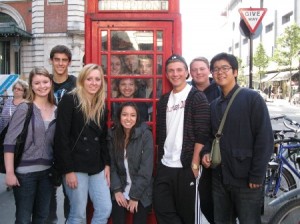
Santa Margarita students enjoyed visiting London before attending the THIMUN-affiliated Royal Russell RRSMUN. The team traveled to 16 conferences this year on the West Coast, East Coast, and abroad at London, Paris, and Beijing.
Model UN is about much more than just the conferences to West Coast schools. Although the West Coast has its share of MUN conferences, students will still want to visit other places. They’ll want to travel to East Coast conferences to compete against the delegates there but more importantly visit different cities and check out colleges that interest them. And students dream about going to a Model UN conference abroad. After all, one should have international experiences if they are going to discuss international relations.
Traveling to conferences, even local ones, is already expensive. Traveling to conferences across the country or around in the world is even more expensive and requires dedicated fundraising efforts. Also, programs need to manage the finances related to running a conference. All this led to the development of parent booster clubs similar to the ones seen on many sports teams.
Parent booster clubs have helped the Model UN programs travel to East Coast conferences — Brown BUSUN, Chicago CIMUN, Duke DUMUNC, Georgetown NAIMUN, Harvard HMUN, Johns Hopkins JHUMUNC, McGill SSUNS, Nationals NHSMUN, Philadelphia PhilMUN, U.Chicago MUNUC, U.Penn ILMUNC, and UNA-USA’s GCIMUN are some of the conferences that various Southern California class and club teams have attended in the past few years. Due to student interest as well as administration requirements, these trips may include study tour components such as visits to historical and cultural sites in New York, Boston, Chicago, Philadelphia, or Washington DC and may last over a week. Since students want to visit new places, teams rarely go back to the same conference on consecutive years, but they’ll usually rotate that conference into the schedule every few years if it was well-organized.
Parent booster clubs also help the MUN programs travel abroad. Southern California teams have gone abroad to THIMUN-affiliated conferences in China, France, Germany, Ireland, Italy, the Netherlands, Russia, and the United Kingdom. Some programs travel abroad every year — although it’s usually an invitational for the most experienced delegates who’ve completed their fundraising — with Santa Margarita being the most prolific of the group with three international conferences this year. The traveling is not just about seeing the world, but also building relationships and exchange connections. Usually the host school at the other country will try to reciprocate by sending a delegation to the attendee’s high school conference. For example, Edison’s EHSMUN conference hosted a school from the UK this Fall.
East Coast teams rarely venture outside their region, but again there is good reason for that. In terms of competition and quality of conferences, there are many available already in their region and it makes sense to save money by staying local instead of flying to a comparable conference. But then again, Model UN is not just about competition. It is about understanding and connecting with other people, whether that’s in different regions within your country or abroad. More East Coast teams should follow the footsteps of teams like Dalton, Chicago Lab, Gulf Coast, Culver Academies, Glenbard West, and Saint Edwards that have ventured out to the West Coast for a different experience. And more East Coast teams should make it a goal to attend a conference abroad, preferably a THIMUN-affiliated conference, so that they can see the world and experience the benefits of an education-focused conference that doesn’t give out awards.
(Personal memories: Although I never got to travel abroad as a high school MUN delegate, I do remember encountering international delegates at local conferences. Ryan and I particularly remember how a few of the Danish delegates at Tustin’s conference during my senior year mentioned how they thought America is tame and boring compared to Denmark. Of course, this was before The O.C. made Orange County cool.).
What do the key differences teach us?
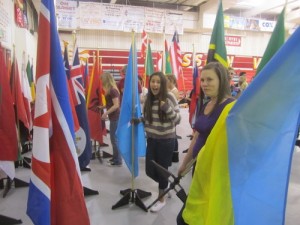
Model UN goes beyond the delegate experience. It's also an opportunity to learn in a classroom setting, lead others by hosting a conference, and travel the world. Mission Viejo students set up for their MVHSMUN conference here.
Looking at the key differences, one conclusion that sums it up is that West Coast MUNers get a lot more training than the East Coast, between having MUN as a class, active advisors, the availability of novice conferences, summer programs, and experiences as chairs. The sports analogy is that the West Coast is like the Netherlands in soccer where academies produce well-trained players from a young age while the East Coast is like Brazil where athletes learn from experience by just playing against the best on the streets — it leads to different values and styles in Model UN. The bigger takeaway for East Coast programs is that most of them may have room for improvement when it comes to training, research, and preparation. The elite programs already do this; teams like Dalton and Horace Mann already prepare thick research binders and that’s partially why they have been so successful.
Another key difference is that West Coast programs try to make the Model UN comprehensive beyond just the competitive delegate experience. Students learn the academic side to international relations, they learn how to lead committees or conferences as chairs and Secretariat members, and they get to learn about the world and meet people outside their region through travels to the East Coast and abroad (and learn to enjoy a MUN conference that doesn’t have awards when they go to THIMUN-affiliated ones). The takeaway here for East Coast programs is that they can add several new dimensions to make their Model UN experience much richer. The student-leaders and teachers should have a strategic discussion on the benefits, feasibility, and interest of hosting their own conference, traveling outside the East Coast, or even lobbying the administration to have Model UN as a class.
Finally, the differences in the circuit setups shows that West Coast teams are very good, and the system contributes to this. When teams have a deep bench of 200-300 MUNers who are trained in a culture of research and preparation and participate at conferences every month, there is a lot of experience and high quality of skills and debate in committees. The key takeaway for East Coast programs is that there are lot of benefits to having a local circuit for both students and teachers, and teams should discuss how they may want to duplicate this — perhaps on a smaller scale with one-day novice conferences — so that they can sustainably grow their own programs as well as others in the local area.
Hopefully this article also sheds light on why West Coast teams rank highly despite having fewer opportunities to showcase themselves to the East Coast circuit. Speaking of rankings, one key similarity is that the majority on both coasts treat Model UN as more of an academic competition and there’s a heavy focus on awards. In contrast, some regions like the Midwest see MUN as more of an educational simulation and put less emphasis on awards.
What if I want to learn more about the West Coast?
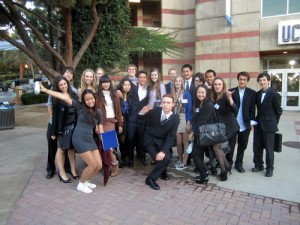
All the West Coast college-hosted conferences take place on campus. Huntington Beach delegates pose in front of the UCLA student union during BruinMUN here.
For East Coast teams that are interested in experiencing the West Coast, the conferences that draw the most teams from outside the region are usually Berkeley BMUN, Stanford SMUNC, and UCLA BruinMUN. Berkeley is the most competitive of the three and is like a smaller version of say, HMUN or ILMUNC. Stanford is the least similar of the three as it is mostly crisis and attended by newer Northern California schools; it’s comparable to CMUNCE in terms of committees. UCLA is the premier Fall conference and is like the West Coast version of a Rutgers, Brown, or William & Mary. Keep in mind that the Northern California conferences don’t necessarily use the points system; those who want to experience the Southern California conference culture may want to try UCLA BruinMUN or UC Irvine UCIMUN, the two largest college-hosted ones in this category. Other college-hosted conferences on the West Coast include UC Davis’ DavisMUN, UC Santa Barbara GauchoMUN, and UC San Diego TritonMUN. All of the aforementioned conferences are hosted on the university campuses, so the conference atmosphere is a bit more like how it is at Yale or George Washington.
Attending a high school-hosted conference may also be an eye-opening experience to observe first-hand how Southern California high schools are able to host large conferences. Two-day high school-hosted conferences include Mission Viejo MVHSMUN, Tustin THSMUN, Huntington Beach Surf City MUN, and Edison EHSMUN. One-day novice conferences include Santa Margarita SOCOMUN, Mira Costa LAIMUN, and Cerritos CHSMUN. There are many other conferences; visit the conferences page for a complete list.
What do you think about the differences between West Coast and East Coast MUN? Let us know in the comments below!

